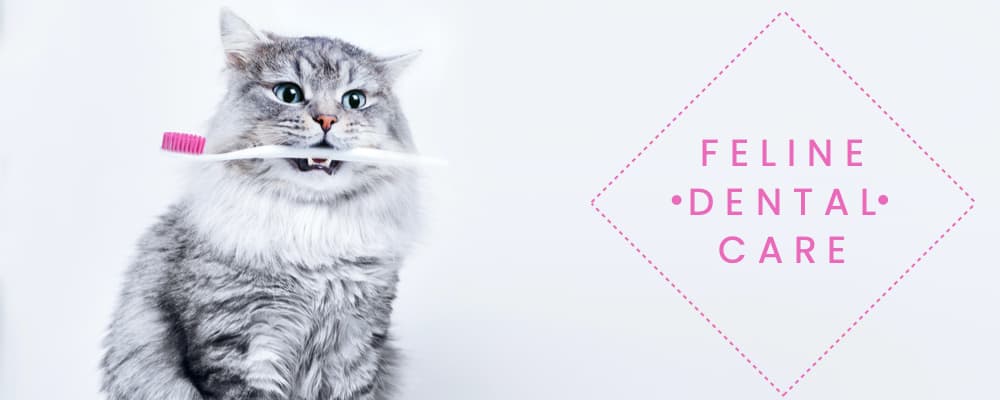Nearly 90 percent of cats develop dental problems over their lifetime. Just like us, they can develop plaque build-up, tartar, gum disease, foul breath, infection and abscesses, all of which can lead to pain and tooth loss. With proper feline dental care and the right type of food, you can help take action against these problems.
If your cat has a tooth problem, it may take a while for you to find out. One reason is that cats instinctively hide their pain so as not to appear vulnerable to predators, so it may take you awhile to figure out that she’s hurting. If she hides more than usual, refuses to eat or sleep, or becomes more aggressive, this could indicate that she’s experiencing tooth pain.
The Problem with Plaque on Your Cat’s Teeth
Plaque is the film you feel on your teeth when you wake up each morning, formed by saliva, bacteria and food particles. Plaque can quickly turn into tartar, a hard yellowish deposit on the teeth. It can also cause gum infection (gingivitis), which is the first stage of periodontal disease. Some 70 percent of cats have periodontal disease by the time they turn two, but other types of gum disease can occur earlier. Bacteria from plaque accumulation can cause infection in the lungs, liver, kidney and heart.
Check for Tell-Tale Signs of Feline Dental Concerns
- Between vet visits, be sure to check your cat for these important warning signs:
- Bad breath: an unusually strong odor may suggest digestive problems or a dental condition
- Bleeding or a dark red line along the gums
- Gum inflammation: swollen gums can lead to gum disease, tooth loss, inability to eat, and can be a sign of kidney disease or feline immunodeficiency virus
- Ulcers on the gums
- Excessive drooling or pawing at the mouth area
- Difficulty chewing food or refusal to eat
Take your cat to the vet immediately if you notice any of these warning signs. Your vet may recommend a professional dental cleaning, which begins with blood work to determine if she’s healthy enough to undergo anesthesia. If she is, your vet will administer anesthesia and begin a comprehensive cleaning. This includes:
- A complete oral exam and x-rays to identify problems under the gum line
- A full cleaning under the gum line to prevent periodontal disease
- Professional scaling to remove plaque and tartar build-up on the crown
- Polishing the teeth to prevent plaque and bacteria from adhering
Preventing Dental Disease by Brushing
The gold standard for cat oral care at home is brushing. If you are willing and able, here is how to brush a cat’s teeth at home:
- Get your cat used to the idea of having her teeth brushed. Keep the sessions short and positive. Gently massage her gums with your finger or a cotton swab.
- Use a toothbrush designed especially for cats; it’s smaller than a human toothbrush and has softer bristles. Toothbrushes that you can wear over your finger are also available.
- Use toothpaste designed for cats; using your own toothpaste can cause distress and upset your cat’s stomach. Your veterinarian can supply you with toothbrushes and toothpaste.
- If your cat has inflamed gums, brushing her teeth too hard might be painful. Visit the vet for a quick check-up before you begin brushing.
- Also, be sure to reward your cat for being so patient while you brush her teeth with either a treat or play. This will let her know that she did a good job, as well as help make future brushings easier on you both.
Alternatives to Brushing Your Cat’s Teeth
Aside from diet, here are some additional recommendations to keep your cat’s teeth and periodontal health at their best.
Prescription Dental Diet – Dental diets are formulated for reducing the amount of plaque and tartar that accumulates on the teeth, and in some cases, may even prevent serious oral diseases from occurring. The larger kibble is composed of fibers that actually scrub the tooth’s surface to reduce plaque
Dental Chews and Treats – Specifically formulated dental treats and food can slow the formation of tartar and avoid the onset of dental disease. Choose treats that are low in sugar, as sugar may worsen or increase the chance of periodontal disease. We strongly recommend treats that have been accepted by the Veterinary Oral Health Council (http://vohc.org/all_accepted_products.html) as being proven effective in controlling plaque and tartar. One dental treat per day will keep your cat’s teeth stimulated and blood flowing as it scrubs away tartar and prevents it from building up.
A healthy mouth is important for overall body health. Consider measures to improve dental health at home and have professional dental cleanings done when recommended by your veterinarian.
